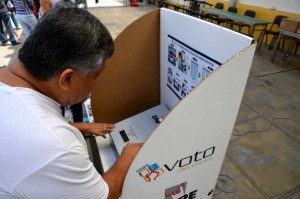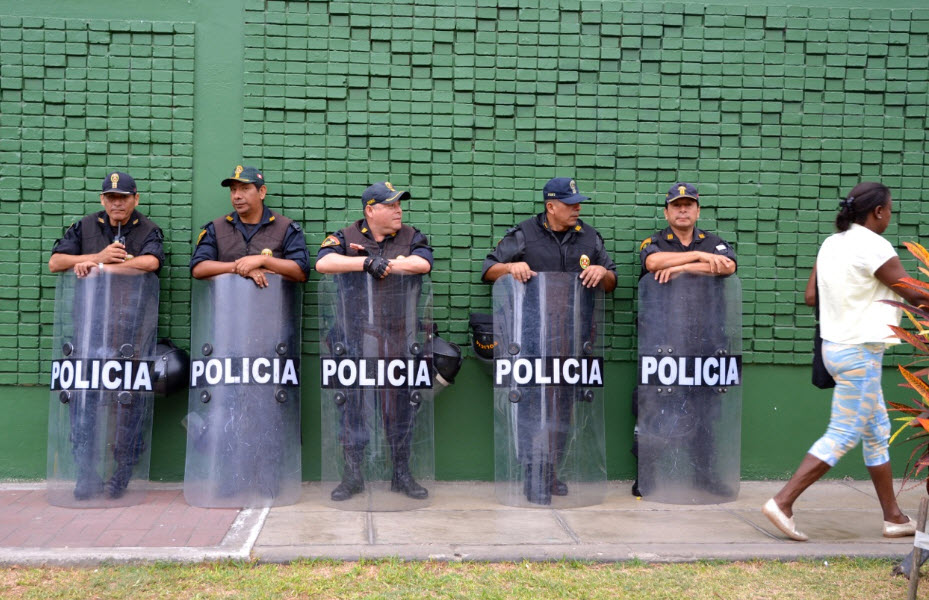Early results suggest Pedro Pablo Kuczynski will edge out Veronika Mendoza to advance to second round.
By Paula Dupraz-Dobias ✐ Special to Peruvian Times ☄
LIMA, PERU — Partial official results Sunday night indicate that Peruvians will return to ballots in June to choose between Keiko Fujimori, the daughter of the jailed former President Alberto Fujimori, and veteran politician Pedro Pablo Kuczynski as their next president.

The results come following a tumultuous campaign including months of indecision regarding candidates that would run for the country’s top executive job.
Peru’s National Office for Electoral Processes (ONPE) announced that Fujimori lead the pack of ten presidential candidates, with 39.18 percent of the vote, followed by Kuczynski, with 24.25 percent, ahead of leftwing candidate Veronika Mendoza, with 16.25 percent. The results reflected 40 percent of the vote, which had been counted.
Non-official polls from surveying firm Ipsos also indicated an advance of Kuczynski with 21.5 percent over Mendoza with 18.7 percent. The survey, which represented 100 percent of the vote, had 39.6 percent going to Fujimori.
Fujimori, 40, a centrist candidate who acted as first lady following her parents’ turbulent separation during her father’s authoritarian presidency, centered her campaign on continued economic growth and security, mirroring key policies of her father.
Kuczynski – also known as PPK – campaigned on liberal economic policies and spoke often about the need to clean up widespread corruption.
The 77-year old served as a central bank official and minister in former governments following a long tenure on Wall Street.
Mendoza, a 35-year old half-French psychologist and politician, fluent in Quechua, said she would change the constitution, implemented in 1993 during Alberto Fujimori’s regime, and increase government involvement in Peru’s mining-centered economy.

Voters’ sentiment
On Sunday, many voters lining up at a huge voting station in the socially diverse Lima district of Chorrillos expressed concerns about the choice of candidates in Sunday’s presidential elections.
More than once, people leaving their assigned “tables” in a school building, set between historic seaside mansions and the district’s slums, commented rather fatalistically that it was God’s will that would determine what sort of government eventually resulted from this year’s tumultuous elections.
While many voters lining up there said they hoped Keiko Fujimori would win the election, others spoke less decisively about their vote. Alberto Fujimori’s legacy for halting terrorist groups throughout the country still represents a strong draw for many Peruvians.
Victoria, a 74-year-old migrant from the central region of Huancayo, recalled how, in the early 1990s, terrorists shot down farmers in cold blood in her village before driving away.
“I remember these things. It left me traumatized.”
Victoria said that while she felt all running candidates were corrupt and would probably reverse their promised policies if elected, she voted for Fujimori, hoping to see an effective governing strategy.
In other parts of the country, Fujimori secured strong support for running a campaign centered on security amd economic growth.
Anti-Keiko protests in Lima and elsewhere, the biggest since the end of her father’s presidency, however appeared to weaken her earlier stronger advance in polls.
Mendoza effect
Ursi Torrado Hudson of polling firm DATUM explained to The Peruvian Times that over recent days another “fear factor” emerged amongst certain parts of the electorate towards Veronika Mendoza.
The Frente Amplio (Wide Front) candidate had gained strongly in March, after two candidates were banned from running following accusations of vote-buying and technical errors.
Formal complaints had been filed against other candidates, before the National Electoral Jury (JNE) — judges responsible for implementing the new electoral law — dismissed them, until a few days before the election.
Mendoza was assistant to Peru’s besieged first lady Nadine Heredia, who faces criminal investigations for alleged money laundering. Mendoza was accused of making entries into Heredia’s now-infamous stolen notebooks, including alleged bank transfers linked to the vast Brazilian corruption case Lava Jato.
Torrado said a campaign against Mendoza had “generated fear” that she would harm Peru economy, “that while things are slowing, the country is still going strong. So the fear factor – saying that she is a leftist candidate – could halt the growth of the candidacy, and allow votes to migrate possibly towards PPK.”
Firm results Monday
ONPE said a full result of ballot results should be released on Monday.
Authorities asked voters earlier Sunday, when earlier polls had Kuczynski and Mendoza running neck to neck, to “stay calm.”
For the first time, electronic voting was introduced in several smaller Lima and Callao districts. Electoral officials were at hand to explain voting procedures to voters.
Voting stations visited by The Peruvian Times around Lima were heavily guarded by some of the 160,000 soldiers and police that were mobilized for the event throughout the country.
On Saturday, four soldiers were killed in an ambush in the cocaine-producing VRAEM region in central-western Peru, by suspected remnants of the Maoist Shining Path insurgency. The soldiers were part of a patrol that had been deployed to secure voting to Marichacra, a town in the Junin region.
The second round of balloting is scheduled for June 5. Peruvian electoral law requires a runoff when none of the candidates gain more than 50 percent of the popular vote.





